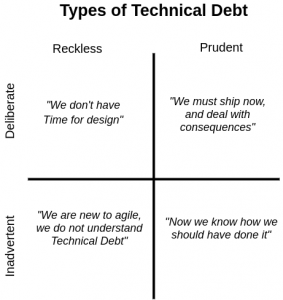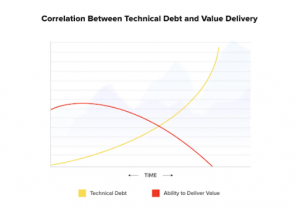Let's Discuss
Enquire NowChoosing an easy solution is always appealing in software development.
However, if something goes wrong, an additional cost of rework may be required. This is a time-consuming task. In the Agile methodology, an easy and faster solution may be chosen to provide faster market delivery, which may result in additional rework in the future, i.e., technical debt.
Software debt is common in software development because companies prioritise speed to market over quality.
This is analogous to putting off paying your bills. By doing so, the bill amount will be added to the interest rate due to the late payment. It becomes difficult for you to pay after so many months.
Technical Debt in Agile
Technical debt is the implied cost of additional work associated with — taking a shortcut to software development and ignoring pending bug fixes (in developed features) to work on new features in order to meet launch dates.
In a nutshell, it is about preferring incremental development over iterative development in Agile. However, this practice only provides short-term benefits while sacrificing long-term value.
Although the product backlog prioritises changes to already developed features in subsequent sprint cycles, they are frequently left unattended.
Technical Debt Example
Assume you send the completed user story to the Agile testing team for approval. There are now two possibilities:
- The testing team discovers some bugs in the developed feature. Your team discards those constraints and moves on to the next user story in the queue. As a result, there is technical debt, which is the additional cost of fixing multiple layers of bugs in one go later.
- The feature is approved by the Agile team. After that, it is integrated, delivered, and deployed into the live environment. When a change is required, later on, developers find it difficult to append the new code to the existing one due to the code’s original confusing structure. As a result, there is technical debt.
Different Types of Technical Debt

- Deliberate– Intentional injection of technical debt
Reckless: This type of debt is caused by poor software architecture. In this case, the development team believes that they do not have enough time to write organised code because they are more concerned with shipping products quickly.
Prudent debt has a small and manageable amount of technical debt. Thus, tech debt can be avoided because it is mostly related to code that rarely needs to be modified.
Prudent: After completing and delivering the feature, the team realises that they could have done better (credits to their learnings). - Inadvertent– Unintentional injection of technical debt
Reckless: The development team is in reckless inadvertent debt because it lacks knowledge and experience with best Agile practices. This could be the case for organisations that are halfway through their Agile transformation. As a result, they unintentionally accumulate debt, which becomes difficult to manage later.
Prudent: After completing and delivering the feature, the team realises that they could have done better (credits to their learnings).
Cost of Technical Debt:
If you look at the cost of technical debt, you’ll see why it’s so important to identify and manage.
Here’s what you’ll lose if you ignore technical debt:
- Delays in bug fixes and new user story launches will result in a loss of customer interest.
- You will need to hire more people to identify and manage technical debt, which may take even longer to recover from.
- Outages in software systems caused by continuous code modification for bug fixes or feature additions
- Continued performance issues that have a negative impact on the product’s responsiveness

Manage Technical Debt
- Organizational Culture Shift:
Create an open organisational culture in which teams can discuss the challenges they face in achieving their goals and developing realistic timelines for completing tasks at hand. - Take daily standups Seriously:
The teams should be able to speak openly about the difficulties they are experiencing. Similarly, the scrum master’s responsibility is to ensure that the highlighted challenges, such as meeting unrealistic goals in a short period of time, are addressed immediately. - Balance Sprints:
Set aside one day per week (for small projects) or an entire week (for large projects) to manage pending tasks. For example, once the team has completed the development of a new user story, they should be given one day per week to work on bug fixes in existing features. - Collective ownership:
Collective ownership implies that any member of the development team can make changes to the code in order to create a new feature, complete a pending task, or implement a bug fix. - Prefer quality over speed:
Quality code should be preferred, even if it takes more time to complete. Do not promote a work culture in which the rate of development is used to determine productivity. The true measure of productivity at any given time should be quality. - Introduce CI/CD:
CI/CD will help in running automated tests for the developed user stories, which, in turn, will help report the bugs faster. - Embrace Microservices Architecture:
The microservices architecture introduces loose coupling, which means that a complete feature or module can exist independently of other features/modules. Due to loose coupling, even if one feature fails, the others continue to function.
No matter how small or large the project, technical debt is a real concern for software development firms. Organizations appear to be falling behind in terms of serving new feature requests and shipping them faster, which leads to poor code quality and skipped refactoring.
The opportunity cost of shipping faster over maintaining high code quality can sometimes be higher than the profits incurred. This is why, as with any financial debt, paying off technical debt is critical. This is a critical lesson in effective product development.
Accepting some technical debt, on the other hand, is acceptable. However, allowing it to grow to the point where it becomes unmanageable should be avoided. If you would like to know more about technical debt and our procedures regarding it, click here.
Disclaimer: The opinions expressed in this article are those of the author(s) and do not necessarily reflect the positions of Dexlock.



